Schubert on tour
Posted by Richard on UTC 2022-04-30 06:21
Putting Schubert on the map
Some years ago the concert guitarist Oliver Woog embarked on a project to document the Schubert Topografie, the places associated with Schubert.
An initial step in this direction had been taken by Rudolf Klein in a book published in 1972, Schubertstätten, 'Schubert's Places', which documented many of the places associated with Schubert. It also provided some social and historical background, the sort of detailed information that has to be left behind in standard biographies.
Schubert was a nomadic spirit, who in a short life changed his residence frequently. Add to those residences the places he visited and the places associated with his intimates means that the Schubert Topografie becomes a much bigger project than it might at first seem.
Your author's unspoken first thought on hearing from Woog about his project was that he ought to consult a therapist. After some further exchanges with him, my conclusion was that if anyone could pull this gigantic project off it would be Woog. The open question was merely the form in which it should be published.
Readers may be wondering why a Topografie is so useful in the case of Franz Schubert: isn't the search for places sanctified by his divine presence really just a manifestation of the Schubert fan's overblown piety?
No, because places and people were of great importance in the composer's short life. It is an interesting fact that almost everyone in Schubert's life came from somewhere else other than Vienna. His parents, uncles and aunts were immigrants, as were many of the adults in his neighbourhood. It was in the nature of his boarding school period that he came into contact with many 'displaced' persons who had been drawn together by the magnet of metropolis: Franz von Schober was happy to put the otherness of his Swedish roots on show, Johann Senn was a Tyrolean patriot to his finger tips and scholars have named the various 'circles of friends' according to their principal provincial roots (Linz, Graz etc.). Schubert was one of the few born-and-bred Viennese in the gang. Particularly his journeys into the Austrian hinterlands are of great importance for him and for our understanding of him.
Over the years, Oliver Woog has carried out extended research on all the places associated with Schubert, going beyond Vienna, and the result of this immense labour is not one book, but a series of six books, collectively titled Schubert Topografie, which document all the places where Schubert laid his head, together with the people and the music associated with those places.
The first of the series, Franz Schubert und sein Freundeskreis in den Schlössern Atzenbrugg und Aumühle, appeared in 2020. We reviewed it here.
The second has now appeared, Franz Schuberts Aufenthalte in Oberösterreich, Salzburg und Umgebung, dealing with Schubert's three tours and visits in Upper Austria, Salzburg and its environs in 1819, 1823 and 1825.
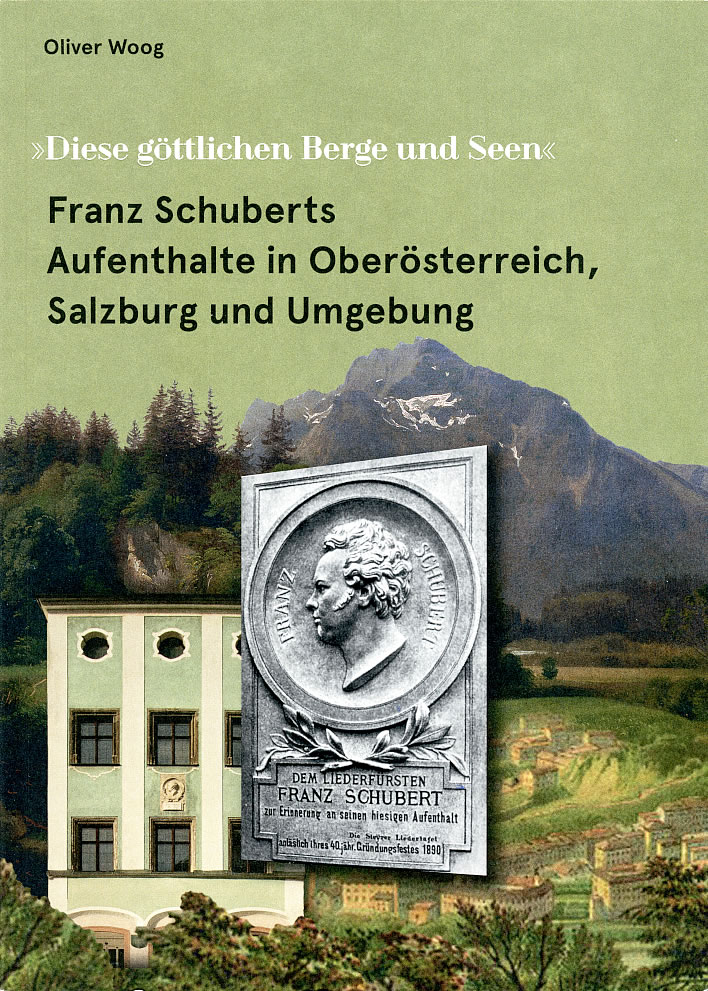
The cover of Oliver Woog's latest volume in his Schubert Topografie, »Diese göttlichen Berge und Seen« Franz Schuberts Aufenthalte in Oberösterreich, Salzburg und Umgebung, Schubert-Projekt-GbR, ISBN: 978-3-9824191-1-4.
Still to appear are:
- ST3: »Verfluchte Sehnsucht nach Wien« Franz Schubert und Wien I
- ST4: »Du fröhliche Stadt, ade!« Franz Schubert und Wien II
- ST5: »Wo ich seit langer Zeit die vergnügtesten Tage verlebt habe« Franz Schubert in Graz, der Steiermark, Niederösterreich und dem Burgenland
- ST6: »Ich lebe und componire wie ein Gott« Franz Schubert in der Slowakei, ehemals Ungarn
To 'document' is a meagre verb to apply to these publications. The two books which have appeared so far are models of their kind: stimulating layout, very good custom maps and many, many illustrations. All of this information is designated and cross-referenced – an organizing and systematising mind has been at work here, indispensable for presenting all this information in a comprehensible fashion:
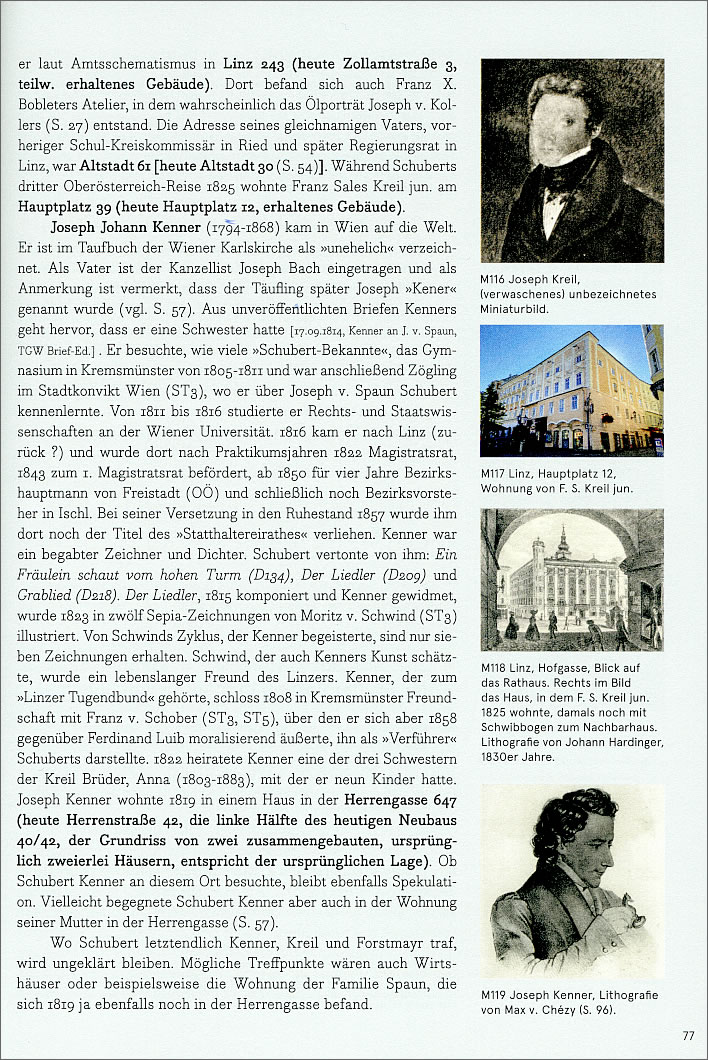
A typical page …
but the book is not a page-turner: the reader often needs to allow time for this mass of material to coalesce in the mind:

… and a typical page of high-density information. We have to allow graphic designers their hobby horses, but so many radically different font styles and families on one page is surely over-egging the custard. In the fifties and the sixties of the last century, the movement that became known as 'Swiss Typography' taught us all about the need for restraint. Why, they would ask, if we identify a marginal comment by its location and layout, why does it need its own font-family as well? Here we have serif and sans serif fonts, roman, italic and bold variants, format changes and coloured backgrounds. Modern graphic designers seem to find this ascetic approach too boring. We ancients long for the days of 'less is more' – the tide should roll back? It is already lapping around our knees. At least in this book we are spared the modern fetish for grey type on grey backgrounds.
Although this sounds like a travel guide from a tourist office, Woog's book is much more. It is firmly rooted in a scholarly tradition. It is carefully researched, well documented and carefully cited. It is also 'up to date', in that it 'fact checks' some of the many howlers and fantastical concepts that have crept into the Schubert narrative since the time of Schubert's first published biography in 1865. It adds well-researched and well-illustrated background about the people whom Schubert encountered in his life and on his travels. Every Schubert scholar will need this work – and the others in the series – to hand.
But the book brings much more than scholarly precision: it is richly illustrated with photographs and facsimiles of music mss. and good, clear maps.
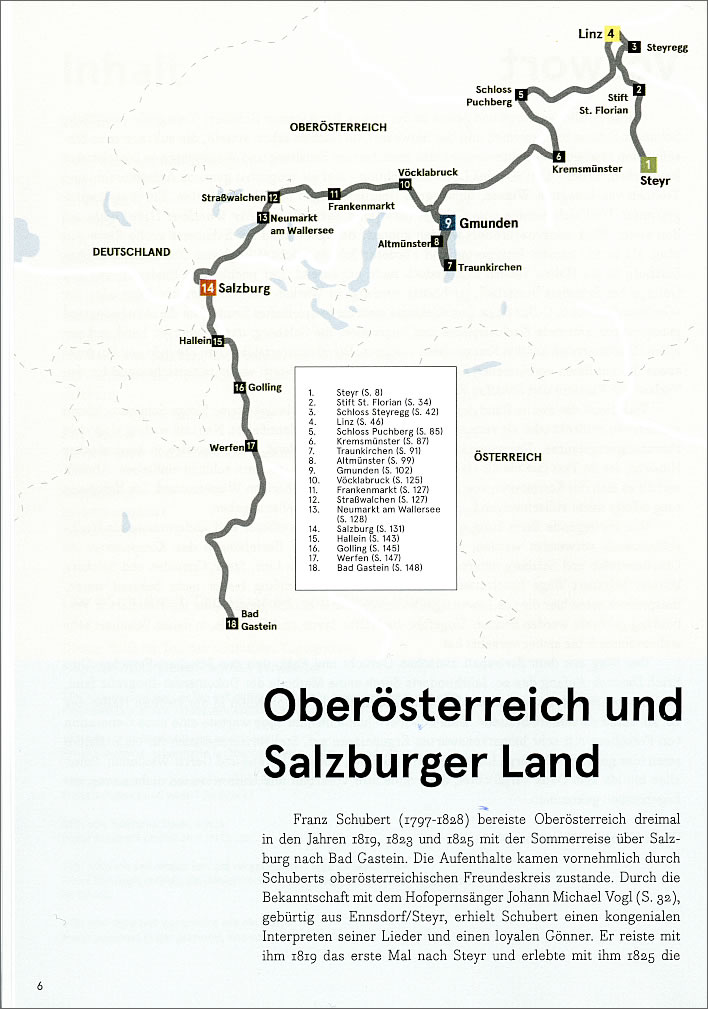
An example of the location maps which people not intimately familiar with Austrian geography will find very helpful.
The localities associated with Schubert's travels are carefully described and illustrated. If anything is still left of those times, then it is to be found in these places. Most of these provincial locations were spared the wrecking ball that made Vienna a modern, motorised city. There was renovation, but there is enough left of the age in these prosperous places despite the centuries of turmoil since.
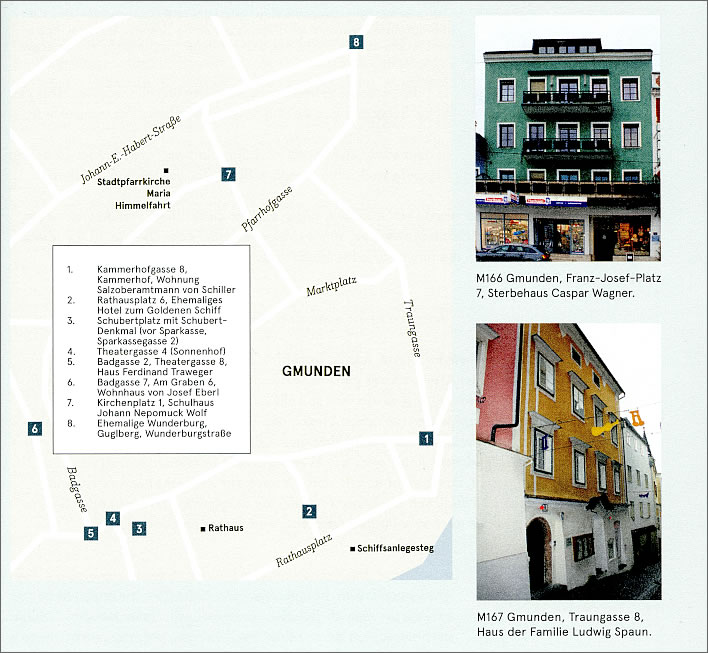
A typical town plan.
Woog has not just made the dense, scholarly subject an attractive read, he will wake in the reader a lust for travel to these destinations. There is no scholarly fear of enthusing people for the subject, which is why he rightly does not shy away, for example, from giving for the modern traveller timed itineraries and visitor information where appropriate.
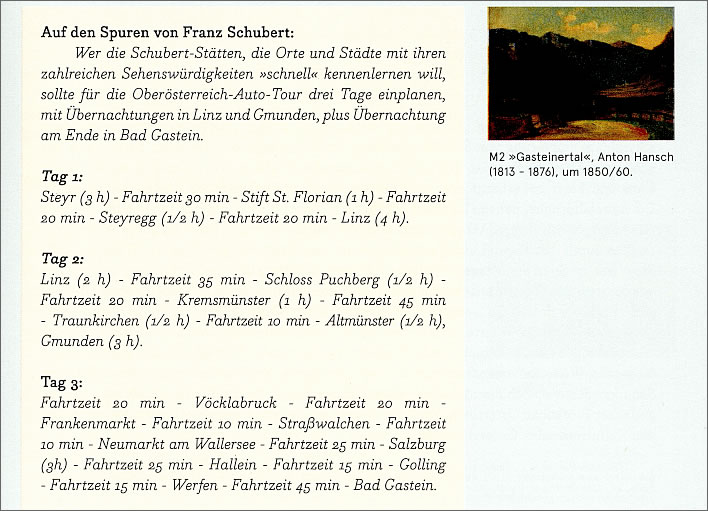
A travel itinerary.
Your reviewer was entertained, too, by what we term nowadays 'trivia'. For example, an aside concerning the acerbic Austrian writer Thomas Bernhard (p120) tells us that Schubert was one of the few composers – one of the few people at all, in fact – to avoid a characteristic Bernhard punishment beating; on another occasion a remark of Schubert's is illuminated by a commentary concerning Untersberger marble (p130).
Linz: a hotbed of troublemakers?
The reviewer was impressed that Woog, in the section on Linz, mentions Franz Seraph Spaun, Joseph Spaun's troublemaking uncle, who is ignored by many Schubert biographers. It is also to his credit that he notes that Franz Seraph's writings were discussed within the Linzer Tugendbund, which was a dangerous thing for them to do.
After Franz Seraph's release from his long imprisonment and his return to Linz, where he stayed with his brother and taught the Spaun children, the authorities kept him under surveillance. It didn't take long before they became worried by his association with a group of French émigrés in Linz.
Although individual troublemakers such as Franz Seraph Spaun were annoying to the authorities, their paranoid minds paid special attention when the troublemakers huddled together in conspiratorial groups. In the same way, Schubert's friend Johann Senn might have remained a free man had he not been associating with other dissidents. His punishment of exile to the Tyrol was designed exactly to deter his participation in subversive associations.
Spaun's case in Linz was a serious scandal; it was the final straw that brought about Franz Seraph's departure from the respectable family home. He would have dragged the careerist Spauns down with him.
Perhaps the revolutionary sentiments in Linz, under the belljar of Emperor Franz's repressive regime, were indeed a background for the Tugendbund and the EOS Gesellschaft. Evidence of this is almost non-existent, since wise people never wrote anything of that sort down, but this geographical cluster for this important theme is another argument for the need for the Schubert Topografie.
In this connection we note that Schubert's first visit to the hotbed Linz took place in August 1819 – only seven months later, the police were banging on Johann Senn's door, an event at which Schubert was present and in the course of which he came close to getting himself arrested. Senn had been arguably Schubert's closest friend. Does it tell us something that for all Schubert's travelling, he never went to the Tyrol?
But enough of that. The book is rounded off with a detailed chronology of Schubert's visits in this region as well as an admirably comprehensive index of names. Clearly, a lot of work went into this book.
Woog makes his subject accessible, so that even those new to the Schubert biography will take much away. And he seems to have done it all so far without needing therapy… let's see what state he is in when volume six appears.
The book is available directly online, or via the usual suspects.
0 Comments UTC Loaded:
Input rules for comments: No HTML, no images. Comments can be nested to a depth of eight. Surround a long quotation with curly braces: {blockquote}. Well-formed URLs will be rendered as links automatically. Do not click on links unless you are confident that they are safe. You have been warned!